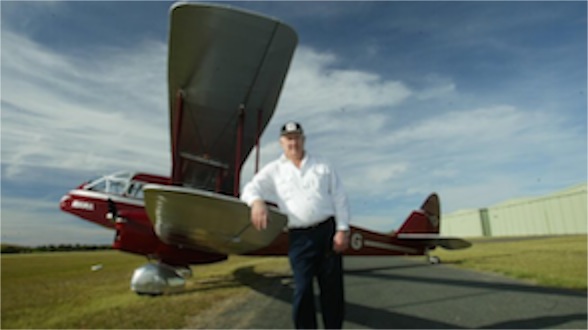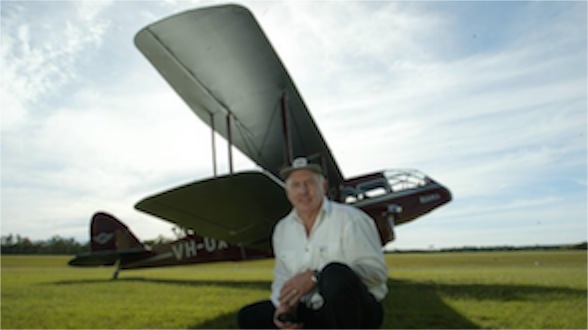Searching for a Dragon
01/10/12 05:33
Sir Geoffrey de Havilland was a pioneer aircraft designer. His company designed some of the most venerable airplanes ever built. The De Havilland Company grew out of the Airco Company around 1920. Prior to that Sir Geoffrey was responsible for probably a dozen aircraft. From 1920 until the company was acquired by the Hawker Siddeley Group in 1969, the design numbers reached 125. Not every design was built, but the productivity and range of aircraft from one design group is truly amazing. They built everything from single passenger biplanes to jet fighters to airliners.
Many designs were named after animals, but that came only after a series named after insects. There were a lot of designs named moth. After the original moth, there was a Gipsy Moth and a Moth Major, a Tiger Moth and a Hawk Moth. Puss Moth, Swallow Moth, Leopard Moth and Hornet Moth were all in the series. And then there was the Mosquito, considered to be the most versatile of all World War II fighters.
Bush pilots know the mammals. The Beaver is perhaps the most famous of all bush planes. There are plenty of 50-year-old Beavers working today. Viking air is a company based on converting Beavers to turboprop engines so they can keep working for many more decades. The company also produced the Otter, and Caribou.
 Along the way there was the Dragon, produced beginning in 1932. It was built during the years of insect planes, and it is possible that the dragon started out with the name dragonfly, but the popular name dragon was the one that stuck. It was Sir Geoffrey’s entrance into the airliner business. The dragon could carry 6 – 10 passengers. The Irish Airline Air Lingus began with a single dragon. In 1986, for the 50th anniversary of the company, they acquired and restored a dragon that is still kept for special occasions.
Along the way there was the Dragon, produced beginning in 1932. It was built during the years of insect planes, and it is possible that the dragon started out with the name dragonfly, but the popular name dragon was the one that stuck. It was Sir Geoffrey’s entrance into the airliner business. The dragon could carry 6 – 10 passengers. The Irish Airline Air Lingus began with a single dragon. In 1986, for the 50th anniversary of the company, they acquired and restored a dragon that is still kept for special occasions.
All in all over 200 dragons were built with a couple of variants in engines. They saw airline service around the globe and served as military transports for at least 15 countries . The dragon was a popular airplane that figured deeply in the founding of Qantas Airlines in Australia.
So my attention is directed toward Australia where a beautiful restored Dragon went missing today. Thick clouds are hampering the search. The airplane was outfitted with an emergency locater transmitter, which did go off, but has subsequently ceased to operate. It is feared that the plane has crashed. It would have to have ceased flying because it would have run out of fuel. It is somewhere along the rugged Queensland Sunshine Coast. The plane was bound to its home base at Cabociture from an airshow in Monto. Pilot was Des Porter. When he was 11 years old Porter was the sole survivor of a plane crash that killed his father and older brother. The airplane in that accident was a DH84 Dragon, flown by Poter’s father.
The missing plane is a beautifully-restored dragon painted red with white trim named Riama. It is a favorite of air shows around Australia.
The community of pilots and fans of antique aircraft is large and extensive. Accidents are not unknown at air shows, but rarely do they involve the antique aircraft. The vintage planes are carefully operated and, for the most part flown only in the best of weather. But accidents do occur.
There is a debate about flying antique aircraft. Some airplanes are considered to be too unique in their design and too unstable for regular flight. They are consigned to museums where they can be seen. The Wright Flyer hangs in the Smithsonian Air and Space Museum. Charles Lindberg’s Spirit of St. Louis is there also. Replicas have been made of these planes, but even the replicas are mostly in museums these days.
But the DH84 Dragon was different. It was made for rugged service. It was known for its excellent flying qualities and reliability. There were Dragons that gave over 50 years of active service as working airplanes. This year marks the 80th anniversary of the design, however, so the only remaining examples are show planes, carefully restored and maintained.
In a best-case scenario, Des Porter was able to walk away from an off-airport landing, the damage to the plane is minimal and both will live to fly another day. In a worst-case scenario, there is deep irony that Porter was flying the same make and model of airplane that took the life of his father and brother 58 years ago.
Australian authorities are searching with the best equipment available. A helicopter and a fixed-wing aircraft equipped with infrared search devices have arrived to assist in the search. It is 9:30 at night in Australia as I writ this, so no news is expected before tomorrow Australia time. We watch and we wait. It is a nervous time.
 Generations of people have looked to the sky and dreamed of flying. The designs of Geoffrey De Havilland have enabled those dreams to take flight. I’m sure Sir Geoffrey never imagined that a plane like the Dragon would still be venerated so many years after its design. It appeared that De Havilland was always looking forward to the next project. He had gone on to jet aircraft before the end of his life and probably had long since forgotten the romance of a biplane airliner with an enclosed cabin that made it possible for so many passengers to take to the air. The idea that people would travel by airplanes and that air travel would become routine was just a pipe dream back in the early 1930’s. Today we can’t imagine life without regular airline service. The pioneers of aviation have changed the way we live and the way we think about getting from one place to another.
Generations of people have looked to the sky and dreamed of flying. The designs of Geoffrey De Havilland have enabled those dreams to take flight. I’m sure Sir Geoffrey never imagined that a plane like the Dragon would still be venerated so many years after its design. It appeared that De Havilland was always looking forward to the next project. He had gone on to jet aircraft before the end of his life and probably had long since forgotten the romance of a biplane airliner with an enclosed cabin that made it possible for so many passengers to take to the air. The idea that people would travel by airplanes and that air travel would become routine was just a pipe dream back in the early 1930’s. Today we can’t imagine life without regular airline service. The pioneers of aviation have changed the way we live and the way we think about getting from one place to another.
The world is waiting for news of the search between Kingaroy and Maleny. Pilots and airplane fans are hoping and praying. Even if the plane is lost. Even if the crash resulted in the death of Des Porter, there will be plenty who think the joys of flying antique airplanes outweigh the risks.
Many designs were named after animals, but that came only after a series named after insects. There were a lot of designs named moth. After the original moth, there was a Gipsy Moth and a Moth Major, a Tiger Moth and a Hawk Moth. Puss Moth, Swallow Moth, Leopard Moth and Hornet Moth were all in the series. And then there was the Mosquito, considered to be the most versatile of all World War II fighters.
Bush pilots know the mammals. The Beaver is perhaps the most famous of all bush planes. There are plenty of 50-year-old Beavers working today. Viking air is a company based on converting Beavers to turboprop engines so they can keep working for many more decades. The company also produced the Otter, and Caribou.

All in all over 200 dragons were built with a couple of variants in engines. They saw airline service around the globe and served as military transports for at least 15 countries . The dragon was a popular airplane that figured deeply in the founding of Qantas Airlines in Australia.
So my attention is directed toward Australia where a beautiful restored Dragon went missing today. Thick clouds are hampering the search. The airplane was outfitted with an emergency locater transmitter, which did go off, but has subsequently ceased to operate. It is feared that the plane has crashed. It would have to have ceased flying because it would have run out of fuel. It is somewhere along the rugged Queensland Sunshine Coast. The plane was bound to its home base at Cabociture from an airshow in Monto. Pilot was Des Porter. When he was 11 years old Porter was the sole survivor of a plane crash that killed his father and older brother. The airplane in that accident was a DH84 Dragon, flown by Poter’s father.
The missing plane is a beautifully-restored dragon painted red with white trim named Riama. It is a favorite of air shows around Australia.
The community of pilots and fans of antique aircraft is large and extensive. Accidents are not unknown at air shows, but rarely do they involve the antique aircraft. The vintage planes are carefully operated and, for the most part flown only in the best of weather. But accidents do occur.
There is a debate about flying antique aircraft. Some airplanes are considered to be too unique in their design and too unstable for regular flight. They are consigned to museums where they can be seen. The Wright Flyer hangs in the Smithsonian Air and Space Museum. Charles Lindberg’s Spirit of St. Louis is there also. Replicas have been made of these planes, but even the replicas are mostly in museums these days.
But the DH84 Dragon was different. It was made for rugged service. It was known for its excellent flying qualities and reliability. There were Dragons that gave over 50 years of active service as working airplanes. This year marks the 80th anniversary of the design, however, so the only remaining examples are show planes, carefully restored and maintained.
In a best-case scenario, Des Porter was able to walk away from an off-airport landing, the damage to the plane is minimal and both will live to fly another day. In a worst-case scenario, there is deep irony that Porter was flying the same make and model of airplane that took the life of his father and brother 58 years ago.
Australian authorities are searching with the best equipment available. A helicopter and a fixed-wing aircraft equipped with infrared search devices have arrived to assist in the search. It is 9:30 at night in Australia as I writ this, so no news is expected before tomorrow Australia time. We watch and we wait. It is a nervous time.

The world is waiting for news of the search between Kingaroy and Maleny. Pilots and airplane fans are hoping and praying. Even if the plane is lost. Even if the crash resulted in the death of Des Porter, there will be plenty who think the joys of flying antique airplanes outweigh the risks.